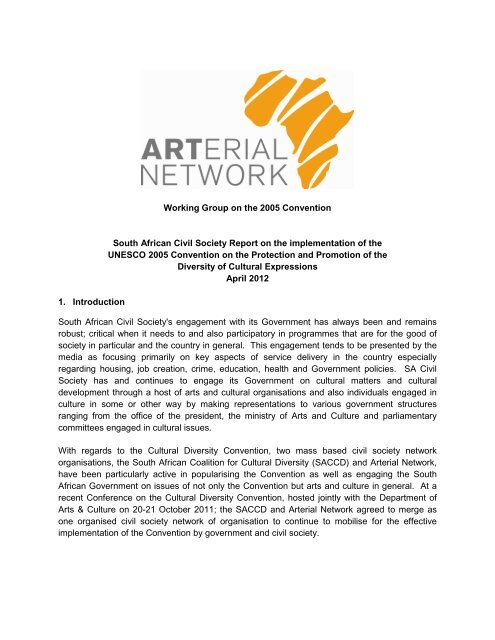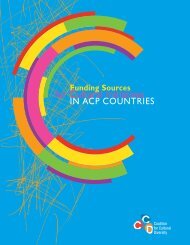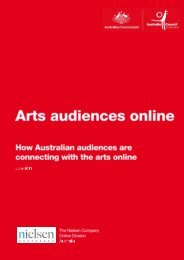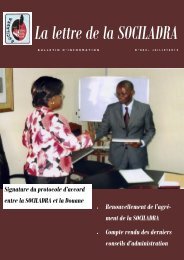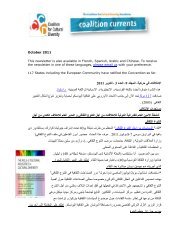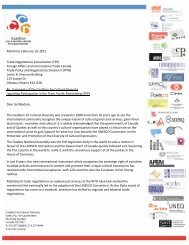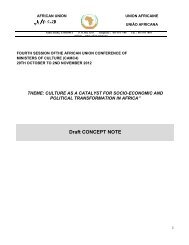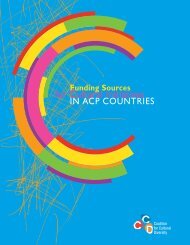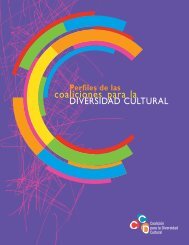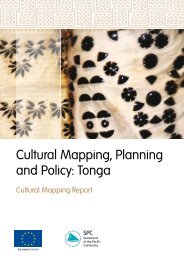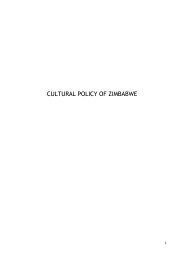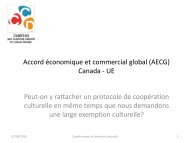South African Civil Society Quadriennal Report.pdf
South African Civil Society Quadriennal Report.pdf
South African Civil Society Quadriennal Report.pdf
You also want an ePaper? Increase the reach of your titles
YUMPU automatically turns print PDFs into web optimized ePapers that Google loves.
Working Group on the 2005 Convention1. Introduction<strong>South</strong> <strong>African</strong> <strong>Civil</strong> <strong>Society</strong> <strong>Report</strong> on the implementation of theUNESCO 2005 Convention on the Protection and Promotion of theDiversity of Cultural ExpressionsApril 2012<strong>South</strong> <strong>African</strong> <strong>Civil</strong> <strong>Society</strong>'s engagement with its Government has always been and remainsrobust; critical when it needs to and also participatory in programmes that are for the good ofsociety in particular and the country in general. This engagement tends to be presented by themedia as focusing primarily on key aspects of service delivery in the country especiallyregarding housing, job creation, crime, education, health and Government policies. SA <strong>Civil</strong><strong>Society</strong> has and continues to engage its Government on cultural matters and culturaldevelopment through a host of arts and cultural organisations and also individuals engaged inculture in some or other way by making representations to various government structuresranging from the office of the president, the ministry of Arts and Culture and parliamentarycommittees engaged in cultural issues.With regards to the Cultural Diversity Convention, two mass based civil society networkorganisations, the <strong>South</strong> <strong>African</strong> Coalition for Cultural Diversity (SACCD) and Arterial Network,have been particularly active in popularising the Convention as well as engaging the <strong>South</strong><strong>African</strong> Government on issues of not only the Convention but arts and culture in general. At arecent Conference on the Cultural Diversity Convention, hosted jointly with the Department ofArts & Culture on 20-21 October 2011; the SACCD and Arterial Network agreed to merge asone organised civil society network of organisation to continue to mobilise for the effectiveimplementation of the Convention by government and civil society.
<strong>Civil</strong> <strong>Society</strong> <strong>Report</strong> - April 2012To drive this mandate in a focused manner a sub-committee referred to as the Arterial Network(SA) Working Group on the 2005 Convention was established. Members of the Working Groupswere democratically elected at this Conference. The following objectives were outlined:oooooooto encourage the active participation of civil society in their efforts to achieve theobjectives of this Convention;to consult with the <strong>South</strong> <strong>African</strong> creative sector in order to develop strategic plans,priorities and strategies in pursuing the goals and intentions of the UNESCOConvention on the Protection and Promotion of the Diversity of Cultural Expressions;to implement strategies to deliver concrete outcomes on an annual basis that areconsistent with the UNESCO Convention;to engage with government (national, provincial and municipal), the private sector,international and continental partners (including other formations in the culturaldiversity sector) in the implementation and pursuit of strategies aimed at realising thegoals of the Convention;to keep the <strong>South</strong> <strong>African</strong> civil society sector - as well as other relevant players andstakeholders informed of progress with regard to the implementation of plans andstrategies intended to realise the goals of the Conventionto solicit and encourage the involvement and participation of the creative sector inthese; andto undertake educational work about the Convention, engage in debates anddevelop theoretical responses from the perspective of civil society in the ongoingdialogue around and implementation of the convention locally, continentally andinternationally, and to keep the <strong>South</strong> <strong>African</strong> creative sector abreast of thesedebates.2. Engaging the SA GovernmentNotwithstanding the <strong>South</strong> <strong>African</strong> government's ratification of the Convention and expression ofcommitment to engage <strong>Civil</strong> <strong>Society</strong> on a number of occasions by Government, the engagementhas been sporadic and left a lot to be desired. The SA Government regularly engages in publicmeetings and consultations with various sectors of society including the arts and culture sector.The arts and culture sector's consultative public meetings, “Izimbizo”, generally tend to discussissues affecting artists and their needs but these discussions but unfortunately not within thecontext of the Convention.After the successful hosting of a conference by Government and <strong>Civil</strong> <strong>Society</strong> in October 2011and a follow up meeting between duly delegated members of the Working Group andGovernment in February 2012, no tangible steps and actions have as yet been taken byGovernment to involve civil society in the drafting of the report. Engagements seem to havestalled and the credentials and bona fides of civil society representatives are questioned bysome Government officials. It is still not clear as to how Government will involve civil society inthe drafting of the report. Urgent reconciliation of these matters needs to be in place so thatadvancement of the objectives of the Convention can proceed.2
<strong>Civil</strong> <strong>Society</strong> <strong>Report</strong> - April 2012In light of the aforementioned, the Working Group resolved to continue with the writing of its ownreport so as to give input into the Government report when required to do so, and also to sharewith other national and international civil society organisations as per the decision of the civilsociety meeting at the 5 th Inter-Governmental Committee meeting of December 2011.3. <strong>Civil</strong> <strong>Society</strong>’s contribution to the <strong>Report</strong>The Arterial Network Working Group on the 2005 Convention appointed a small task team todrive the research and engagement with <strong>Civil</strong> <strong>Society</strong> and in some aspects also government.The members of this task team are Mhlanganisi Masoga, Christa Rautenbach, Mike van Graanand Nhlanhla Maake.The <strong>South</strong> <strong>African</strong> <strong>Civil</strong> <strong>Society</strong>, represented by Mhlanganisi Masoga, also participated in the 5 thInter-Governmental Committee meeting held at UNESCO Headquarters in December 2011.Along with other civil society organisations, the <strong>South</strong> <strong>African</strong> civil society agreed to assist eachother to prepare civil society contributions to the Quadrennial reports. An exchange sessionbetween civil society representatives and State Parties was also held in Paris prior to themeeting of the Intergovernmental Committee to explore the “role of civil society in thepreparation of the quadrennial periodic reports”.A draft questionnaire was developed to assist <strong>Civil</strong> <strong>Society</strong> organisations to research theirsectors and contribute to their country reports as well as to prepare shadow reports. Theobjectives of this intervention were stated as follows:• To give voice to the concerns of civil society groups on the issues that got them interested insupporting the Convention, from their perspective.• To bring transparency to the whole exercise through a clearinghouse where civil societycontributions to their national authorities can be accessed and compared with the reportsubmitted by the State Party.• To inform cultural policy making for the better protection and promotion of the diversity ofcultural expressions.• To provide a minimal set of issues of common concern, to be answered by all with sectorspecific references. Each could add additional questions if desired.Based on the draft questionnaire developed through the collaboration of International NGOs the<strong>South</strong> <strong>African</strong> task team adapted this questionnaire to meet the needs of civil society in <strong>South</strong>Africa. The questionnaire was distributed and responses solicited through Facebook, email,telephone calls, and also published through newspapers and internet articles including amongstothers, The Star and Times newspapers, ArtsSmart, ArtTimes, BASA and the UNESCOwebsite. Contact was also made with the nine Provincial Departments of Arts & Culture toassist in identifying and supplying databases and contacts of artists and arts groups in theirprovinces.3
<strong>Civil</strong> <strong>Society</strong> <strong>Report</strong> - April 20124. Summary of ResponsesThe questionnaire consisted on twenty questions designed to determine awareness of theconvention, understanding of the convention, awareness of Government’s role in implementingthe convention, civil society’s own activities linked to the convention.In spite of time constraints, 149 individuals and organisations responded to the questionnaire.24 responses are from individual artists with six of these being musicians, one attorney and oneactor. A fairly wide and representative spread of cultural and creative industries organisationsresponded to the survey.32 organisations that work across the various genres, disciplines and development issuesparticipated; with 10 of these being cultural and creative industries development organisations,11 Community Arts Centres and 11 Theatre Companies (inclusive of community based theatreorganisations). Up to 20 discipline specific organisations participated with eight of these beingcraft, four visual arts, one literature, one language/translations, two heritage organisations aswell as four dance companies.A significant percentage of the organisations mentioned above are involved in arts and culturedevelopment across the various phases of the value chain including education and training.Responses were also received from four universities and of these three were from musicdepartments, with one being from digital media and film and two from a legal department. 27creative industries companies responded consisting of one royalty collecting society, sixpublishing and media, 13 music industry, one fashion and design as well as seven film anddigital media companies. Three responses were received from individuals working in arts andculture government departments at national and provincial levels.The majority of responses came from Gauteng Province with 54.5%, followed by Western Capewith 16.6%, KwaZulu Natal at 13.8%, Limpopo at 8.3 %, Eastern Cape at 6.9%, North West at3.4% and Free State, Northern Cape and Mpumalanga severally at 0.7%. It is most likely thatthese results are reflective on the internet accessibility rates of the different provinces, with themore urban provinces recording a higher participation. It is therefore plausible to conclude thatthe results are derived from a representative sample.As mentioned before, the objectives of this survey have been to determine awareness as wellas understanding of the Convention, awareness of Government’s role in implementing theConvention and civil society’s own activities linked to the Convention. A copy of the results isattached hereto as ANNEXURE A.4
<strong>Civil</strong> <strong>Society</strong> <strong>Report</strong> - April 20124.1 Responses on Awareness & UnderstandingWhen asked if they were aware of the 2005 Convention, 49% of the respondents stated thatthey were aware and 51% that they were not aware. When it came to the question of havingread the Convention and understanding it, the overall percentage dropped dramatically to 26%.Only 18% of the respondents had devised programmes or activities framed by the Convention,with 42% saying that they had none, while 38% said that the Convention was not applicable totheir programmes. A follow up question about the respondents' programmes, activities and theirrelation to the Convention more or less confirmed the initial results with 19.9% of respondentssaying that they had programmes that were pursuing the objectives and principles of theConvention; with 28.7% responded that some of their programmes did pursue the Conventionsobjectives and principles, while 51.5% said their programmes were not informed by theConvention.When asked to give details of these programmes and how they were pursuing the objectives ofthe 2005 Convention, it became clear that only about 10% of all respondents were consciouslyaware of the Convention and had framed their programmes in line with the Convention. The restwere just implementing arts and culture programmes without any reference to the Convention.In probing further the understanding of the Convention respondents were asked to select adescription that best explained the intention of the Convention, 38.7% of the respondents saidthe Convention was meant to promote linguistic, cultural, racial and ethnic diversity and respectfor such diversity; 22.5% responded that it was meant to promote the creative industries andaccess to a variety of creative products and services from a range of regions in the world; while14.1% said it was meant to protect cultural and language diversity from the negative impact ofglobalisation. Lastly, 33.1% said that they did not know what the objectives of the Conventionwere.4.2 Responses on Awareness of Government's efforts in implementing the Convention42% of the respondents responded that they were aware that <strong>South</strong> Africa was a signatory tothe 2005 Convention, however, only 12,5% were aware that <strong>South</strong> Africa was represented bythe late Prof. Kader Asmal who was actively involved in the drafting of the Convention. Only11% of the responded were aware of any steps that the <strong>South</strong> <strong>African</strong> Government hadundertaken to inform civil society about the 2005 Convention, but this was largely as a result ofthe October 2011 conference that was hosted by the Department of Arts and Culture inpartnership with civil society organisations.With regards to Government's policies and strategies to implement the Convention, only 6.3%indicated that they were aware of such. When probed further on details about such policies andstrategies, it again became clear that at least 10% of respondents were aware of theprogrammes being implemented by the Department of Arts & Culture, the Department of5
<strong>Civil</strong> <strong>Society</strong> <strong>Report</strong> - April 2012Education and the International Relations Unit in the Department of Arts Culture but could notgive any details of specific policies and strategies that were framed and informed by the 2005Convention.56.4% of the respondents said they were aware of cultural expressions that were under threat ofextinction or suppression in <strong>South</strong> Africa. The details submitted reflect miscellaneous concerns;some of which are actually decrying the reduced support for Western classical music, art, ballet,etc. A sample of the responses is provided below:• Television programmes are not entirely representative of <strong>South</strong> <strong>African</strong> identity.• There is a general anglicised culture in <strong>South</strong> Africa which is threatening all indigenouscultures.• Freedom of expression and artists’ rights to produce creative work e.g. Andries Botha'sElephants.• There is a general anglicised culture in <strong>South</strong> Africa which is threatening all indigenouscultures.• Afrikaans language & community, including Afrikaner and Khoisan.• We do not hear or see any cultural expression of the San people in <strong>South</strong> Africa.• Isithonga language and Isibhaca language & cultures.• People of the Kalahari and the Khoi San.• Ceramics, due to a lack of tertiary courses offered, local appreciation, inability for ruralpotters to pass on the skill to the next generation due to poor income generation andrecognition.• The threat posed by cheap mass produced imports.• Classical ballet.• Local dye-houses have closed down and there are only a handful left across the country.They have been crushed by Chinese imports and a shrinking local clothing manufacturingindustry.• Lack of financial support from Government causing most established dance organisations todo less therefore reach less and therefore likely to close their doors.• Pre Apartheid art.• Lesiba Sotho mouth bow playing techniques, music and history.• Choral music.• Clay figure making tradition from the Tyume Valley, Hogsback.• Many traditional handcraft techniques.• Performance of Shakespeare.• Some Universities are closing <strong>African</strong> Language units as they have no students.• Indigenous <strong>African</strong> music is at the risk of extinction because our country does not promote itenough. There's a one 30mın programme on TV once a week dedicated to this genre andthe media never discuss this music like they do American music.6
<strong>Civil</strong> <strong>Society</strong> <strong>Report</strong> - April 2012g) that, clearly – notwithstanding SA’s role in adoption of the Convention and the four yearssince then - the <strong>South</strong> <strong>African</strong> government is only at the very beginning of engaging andinvolving civil society in the formulation and implementation of policies, strategies andprojects aligned to the Conventionh) that there is much work that civil society is engaged in that may be consistent with theintentions of the Convention, but that this work is being done despite – not because of –the Convention, the SA government or civil society structures for that matteri) that the key deficiency in realizing one of the main aims of the Convention i.e. to buildinternational markets for creative goods and services from the global south, is funding sothat knowledge of the Convention and its potential benefits on the one hand and fundingon the other are the two items most needed for the Convention to have any significantinfluence within and on the <strong>South</strong> <strong>African</strong> creative sector5.2 RecommendationsFlowing from the above, we submit the following key recommendations:a) that a targeted awareness campaign be implemented, to inform civil society in asustained manner about the Convention, its potential benefits and how it may be used toinform local practice and international relationships/partnershipsb) that a toolkit/handbook (or adapt an existing one, if any exists) on the Convention bedeveloped, to provide clear, practical guidelines on the Convention and its benefitsc) that the basic texts of the Convention and available toolkits be translated into at leastfive official <strong>South</strong> <strong>African</strong> languages initially, covering one Nguni language, one Sotholanguage, Tshivenda, Afrikaans and Xitsonga.d) that a civil society structure not only needs to exist, but needs to be resourced in asustainable manner in order to engage with government on the implementation of theConvention, to monitor such implementation and to research and publish information atleast annually on practical achievements aligned with the Conventione) that – as with the International Fund for Cultural Diversity – a local/<strong>South</strong> <strong>African</strong> fundfor cultural diversity needs to be established/made available to incentivise the creation ofprojects that realise the intentions and goals of the Convention, with government andcivil society representatives jointly making decisions about projects to be fundedf) that Arterial Network SA needs to establish and drive a number of practical projects thatfacilitate partnerships with other <strong>African</strong> countries, as well as countries in the globalsouth and with the global north that give practical effect to some of the key aims of theConvention8
<strong>Civil</strong> <strong>Society</strong> <strong>Report</strong> - April 2012<strong>Report</strong> compiled by Task Team Members of the Arterial Network2005 Convention Working Group• Mr Mhlanganisi Masoga (SAMRO, Johannesburg)mhlanganisi.masoga@samro.org.za• Prof Christa Rautenbach (North-West University, Potchefstroom)christa.rautenbach@nwu.ac.za• Prof Nhlanhla Maake (University of the Limpopo, Polokwane)n.maake@yahoo.co.uk• Mr. Mike van Graan (Arterial Network – Continental)art27m@iafrica.com9


